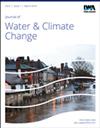采用分层聚类方法对印度南部流域的流量持续时间曲线进行区域化分析
IF 3.1
4区 环境科学与生态学
Q2 WATER RESOURCES
引用次数: 0
摘要
本项水文区域化研究旨在评估分层聚类分析在划分水文同质区域方面的实用性,以及多元线性回归(MLR)模型在信息传递方面的实用性,从而得出无测站流域的流量持续时间曲线(FDC)。为此,我们确定了印度南部 50 个流量基本不受管制的流域,并创建了一个包含历史溪流记录和 16 个流域属性的数据集。利用选定的集水区属性,采用分层聚类法划分出三个水文同质区域,并得出了相应聚类中每个集水区的九个流量定量(10-90%)。然后采用区域化方法,利用逐步回归法,通过 MLR 模型将流量定量与容易得出的流域物理特征联系起来。对所开发模型的分组性能分析表明,分组-1、分组-2 和分组-3 的性能优异,平均判定系数 (R2) 分别为 0.85、0.97 和 0.8,而将所有 50 个站点视为一个区域时,性能则较差。然而,积刀交叉验证在所建立模型的可靠性方面表现不一,高流量定量模型表现较好,而低流量定量模型表现较差。本文章由计算机程序翻译,如有差异,请以英文原文为准。
Regionalization of flow duration curves for catchments in southern India using a hierarchical cluster approach
The present study on the hydrologic regionalization was taken up to evaluate the utility of hierarchical cluster analysis for the delineation of hydrologically homogeneous regions and multiple linear regression (MLR) models for information transfer to derive flow duration curve (FDC) in ungauged basins. For this purpose, 50 catchments with largely unregulated flows located in South India were identified and a dataset of historical streamflow records and 16 catchment attributes was created. Using selected catchment attributes, three hydrologically homogenous regions were delineated using a hierarchical agglomerative cluster approach, and nine flow quantiles (10–90%) for each of the catchments in the respective clusters was derived. Regionalization approach was then adopted, whereby using step-wise regression, flow quantiles were related with readily derived basin-physical characteristics through MLR models. Cluster-wise performance analysis of the developed models indicated excellent performance with an average coefficient of determination (R2) values of 0.85, 0.97, and 0.8 for Cluster-1, -2, and -3, respectively, in comparison to poor performance when all 50 stations were considered to be in a single region. However, Jackknife cross-validation showed mixed performances with regard to the reliability of developed models with performance being good for high-flow quantiles and poor for low-flow quantiles.
求助全文
通过发布文献求助,成功后即可免费获取论文全文。
去求助
来源期刊

Journal of Water and Climate Change
WATER RESOURCES-
CiteScore
4.80
自引率
10.70%
发文量
168
审稿时长
>12 weeks
期刊介绍:
Journal of Water and Climate Change publishes refereed research and practitioner papers on all aspects of water science, technology, management and innovation in response to climate change, with emphasis on reduction of energy usage.
 求助内容:
求助内容: 应助结果提醒方式:
应助结果提醒方式:


